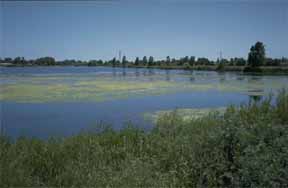The objective of these lessons is to learn about redox chemistry
and aquatic nutrient cycling through the study of eutrophication. Eutrophication
is defined as the excessive enrichment of waters with nutrients, and the
associated adverse biological effects.
The information below was excerpted from a tutorial on eutrophication
(http://www.mp-docker.demon.co.uk/environmental_chemistry/topic_4b/)
The main causes of eutrophication are
* natural run-off of nutrients from the soil and the weathering of rocks
* run-off of inorganic fertilizer (containing nitrates and phosphates)
* run-off of manure from farms (containing nitrates, phosphates and ammonia)
* run-off from erosion (following mining, construction work or poor land
use)
* discharge of detergents (containing phosphates)
* discharge of partially treated or untreated sewage (containing nitrates
and phosphates)
The main effects of eutrophication are an
* increase in plant and animal biomass
* increase in growth of rooted plants, e.g. reeds
* increase in turbidity (cloudiness) of water
* increase in rate of sedimentation
* development of anoxic conditions (low oxygen levels)
* decrease in species diversity
* change in dominant biota (e.g. carp replace trout and blue-green algae
replace normal algae) and an
* increase in the frequency of algal blooms.
Some of the main consequences of eutrophication are
* increased vegetation may impede water flow and the movement of boats
* the water may become unsuitable for drinking even after treatment
* decrease in the amenity value of the water (e.g. it may become unsuitable
for water sports such as sailing)
* disappearance of commercially important species (such as trout)
A reduction in the extent of artificial eutrophication can (in principle)
be achieved by
* reducing the use of phosphates as builders in detergents
* reducing the use of nitrate containing fertilizers
* using tertiary sewage treatment methods to remove phosphate and nitrate
before discharge of the effluent into rivers and lakes
* directing waste water away from lakes to rivers and the sea
* aerating lakes and reservoirs to prevent oxygen depletion particularly
during algal blooms
* removing phosphate-rich plant material from affected lakes
* removing phosphate-rich sediments by dredging.
Eutrophication Links
Eutrophication
movie
Eutrophication: Biochemical Oxygen Demand; Nutrients; Redox Processes
Biochemical Energy Flow in Aquatic Ecosystems
Spiro, pp. 224-228.
Eutrophication
Spiro, pp. 228-239.
Discussion & HW:
Handout problems 13-21
Eutrophication: Biochemical Energy Flow in Aquatic Ecosystems; Water Treatment
Water Treatment
Spiro, pp. 240-248.
|

